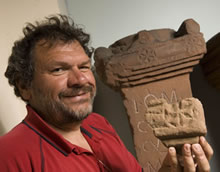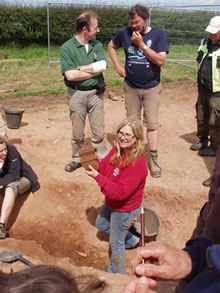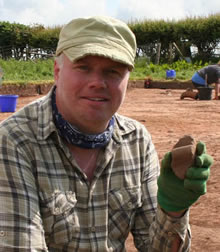Archive Press Releases
11th Jan 2012 - Maryport dig director nominated for national award
 Tony WilmottTony Wilmott, director of last year's excavations at the Roman fort and vicus, Maryport, has been nominated for ‘Archaeologist of the year' at the Current Archaeology Awards.
Tony WilmottTony Wilmott, director of last year's excavations at the Roman fort and vicus, Maryport, has been nominated for ‘Archaeologist of the year' at the Current Archaeology Awards.
Tony is the Senior Archaeologist for English Heritage and is one of our most renowned excavators of Roman sites in Britain. An authority on Hadrian's Wall he has excavated at Birdoswald near Carlisle, Chester and Richborough.
Tony's proudest archaeological achievement was the discovery at Birdoswald Roman fort of the post-Roman timber buildings. These were revealed to him when he stood on top of the tower of the adjacent farmhouse.
His favourite moment of 2011 was the discovery that the Maryport Roman altars had been used as packing in the post-pits of a huge late-Roman timber building. This blew received ideas about reverent ritual burial out of the water. Tony said about this experience:
"Overturning established ideas by further excavation is a real highlight in any archaeological life".
Tony said about the future of archaeology:
"Now is the time when the various branches of archaeology - academic, public, commercial, and amateur - need to take a long hard look at how they can co-operate. There are encouraging signs of this and some good models to follow".
Certainly Tony's larger-than-life persona was a big hit with the local volunteers and visitors to the site who enjoyed his entertaining and inspiring tours of the excavation site.
It is expected that Tony will be returning to Maryport in the summer to continue the research excavation commissioned and funded by the Senhouse Museum Trust.
Anyone can vote for Tony online at http://archaeologyawards.org/2012/archaeologist-of-the-year-2012.htm. The winner of the award will be announced at the Current Archaeology Live! Conference on 3rd March held at the University of London.
More details about the awards can be found at www.archaeologyawards.org
The Senhouse Roman Museum displays the largest group of Roman military altar stones and inscriptions from any site in Britain and unique examples of Romano-British religious sculpture.
The collection, which was begun by the Senhouse family in the 1570s, is the oldest private collection in the country, and is of international importance.
Most of the objects in the museum derive from the fort at Maryport and the Roman civilian settlement attached to it. Recent geophysical survey revealed the site to be one of the largest and best preserved in the north.
2nd Nov 2011 - The Frontiers of the Roman Empire under attack
In Maryport, a small town on the Solway coast, where for many years the Romans faced a barbarian enemy across the sea, a battle is being played out between a housing developer, Story Homes, and those keen to preserve an internationally important archaeological site. I am hoping that this might form the basis of a Guardian article, as it touches on a number of sensitive issues, not least that of 'localism', heritage, and the Government's overhaul of the planning system.
Story Homes (a Carlisle-based builder) have applied to build 152 new houses on a green-field site close to the heart of Maryport. The field in question (known locally as the Deer Park) is stiff with archaeology, including a British settlement 'of considerable interest', according to English Heritage, a Roman cremation cemetery 'of national significance', a Roman road and many other features of, as yet, unknown significance.
The site lies immediately adjacent to the UNESCO World Heritage Site 'Frontiers of the Roman Empire' and no more than a few hundred metres from an internationally important Roman fort established in the first century. Recent excavations by Newcastle University outside the fort (see attached photograph and Current Archaeology, October 2011) have revealed the foundations of a very large late Roman building, confirming that the Maryport site remained important into the fourth century. I have attached maps showing the scale of the proposed development and the relationship of its location to the currently scheduled area.
Locals are up in arms and UNESCO, already concerned about past failures to protect the Hadrian's Wall World Heritage Site, is likely to get involved. A letter objecting to the plan has been lodged by ICOMOS (International Council on Monuments & Sites), which advises UNESCO on these matters, with Allerdale Borough Council, whose planners are to be the arbiters of the site's fate. Archaeologists as far afield as Vancouver have written to protest. The development would funnel traffic down an already dangerous road much travelled, on foot, by hundreds of local school-children (the headmaster has not been consulted!) and destroy a scenic and much-loved approach to the town (see attached photograph).
English Heritage, which one would have hoped would defend the World Heritage Site and its setting, has decided to throw in its lot with the developers. Its North West regional office is actively supporting the plan. If the development goes forward, the developer has agreed to provide access through the Deer Park to a visitor development planned by Hadrian's Wall Heritage Limited, a company established by English Heritage and others. The proposed access would cross the line of the Roman road to the fort and 'float' across the site of the Roman cemetery. An alternative access route, not damaging any known archaeology, is available.
EH Chief Executive Simon Thurley, in the October issue of Current Archaeology (which ironically enough features Roman Maryport on its cover), says in reference to the new National Planning Framework: 'I think readers should be concerned as well. Anyone who cares about archaeology in this country should make their views known. It is incredibly important that individuals express their concerns as well as organisations. The stakes couldn't be higher.'
Meanwhile, the organisation he heads says of the Maryport site, for the benefit of the developers, that 'the proposed development lies outside the boundary of the World Heritage Site and there will therefore have no direct impact'. This statement blithely disregards the advice in the 2009 official circular on the protection of World Heritage Sites that 'it is important to consider carefully how to protect the setting of each World Heritage Site so that its outstanding universal value, integrity, authenticity and significance are not adversely affected by inappropriate change or development.'
Those of us campaigning against the proposed housing development think this is an unholy alliance between the developers, Hadrian's Wall Heritage and English Heritage against the long-term preservation of the town's Roman archaeology and the clearly stated wishes of the majority of local people. A petition circulated locally has already secured more than 1,000 signatures and a well-attended public meeting has voted to oppose the development. For further details, see local newspaper reports on the following links:
Simon Thurley (EH Chairman) again: 'All the nicest places to live in, work in and visit are places with a heritage behind them; all the places which work do so because people have a sense of pride in their history.'
I hope that you think this is a story worthy of national exposure. Let me know if you agree, and if I can help with further details and information.
Peter Greggains
30th June 2011 - Exciting excavation find made by roman museum curator
 Archaeological dig led by Professor Ian Haynes of Newcastle UniversityAnother exciting find has been made at the Maryport archaeological dig led by Professor Ian Haynes of Newcastle University with leading field archaeologist Tony Wilmott.
Archaeological dig led by Professor Ian Haynes of Newcastle UniversityAnother exciting find has been made at the Maryport archaeological dig led by Professor Ian Haynes of Newcastle University with leading field archaeologist Tony Wilmott.
Jane Laskey, curator of the Senhouse Roman Museum next to the site at Camp Farm made the discovery on Wednesday 29 June.
It is a large piece of another altar stone - the site is internationally famous for the cache of 17 altar stones found there in 1870 and now on display in the museum - 22cm high and 12 cm wide, found 75cm below the ground surface in a Roman ditch.
Mrs Laskey, who has been the curator at the museum since 2002 said: "Emma, one of the Newcastle University student volunteers and I were excavating the fill of the ditch when we discovered some stone in the bottom.
"Dave, the site supervisor, asked us to remove it. The last stone was a fragment from the top of an altar. I recognised the shape instantly. Emma screamed and the whole site team rushed over to see.
"This is a very exciting find for me because of my close connection with the collection, but it is an achievement for the whole team.
"I have already been through the museum collection to find a similar altar fragment, but this looks like evidence for another completely different altar existing at Maryport."
The first find was made just days into the dig at the beginning of June, and is a smaller altar fragment, also from a different altar not already in the collection at the museum.
Ian Haynes said: "This new fragment has part of the capital of an altar with pulvini - that is part of the top of the altar and a section of one of the scroll like features that runs along its edge.
"My thoughts on the ditch at the moment are that it could have been dug to enclose a sacred space but further evidence is needed. The ditch edges were clearly maintained originally, we can see some attempt to reinforce them made in certain areas which was to prevent the sandy edges crumbling.
"However, because of the position and material surrounding the altar fragment when it was found it looks as if it was discarded in the ditch, which was then allowed to fill up. Fragments of Roman pottery found in the ditch are all Antonine or later, suggesting it was filling up or was filled up in the late second or early third centuries AD."
Maryport - with a Roman fort and large civilian settlement - was a key part of the frontier coastal defences extending from Hadrian's Wall and is now part of the 150 mile Hadrian's Wall World Heritage Site.
Senhouse Museum Trust has commissioned the excavation and provided funding of £50,000 towards the total cost of the fieldwork. The team will excavate through to 20 July.
Professor David Breeze of the Senhouse Museum Trust said: "The Senhouse Museum Trust is delighted that we are learning more about the find-spot of the altars.
"The two fragments of altars show that not all was removed in 1870 and new discoveries will help our interpretation of the altars and sculpture in the museum to visitors."
Newcastle University archaeology student makes find at Maryport
 Eric WatersFirst year archaeology student Eric Waters from Jarrow, part of the team from Newcastle University excavating at an internationally important Roman site in Maryport, Cumbria, has made the first find - just days into the dig.
Eric WatersFirst year archaeology student Eric Waters from Jarrow, part of the team from Newcastle University excavating at an internationally important Roman site in Maryport, Cumbria, has made the first find - just days into the dig.
The find is a carved red sandstone fragment of a Roman altar stone with a small scroll. It was discovered during the clearance of the surface soil layers.
Eric, 43, worked at Nissan in Sunderland for 17 years before taking voluntary redundancy two years ago to pursue his interest in archaeology and gaining a place to study at Newcastle University.
He said: "This is my first excavation and I wasn't sure what I'd found but it was obviously not just a stone, it had a definite curved shape."
Archaeologists Tony Wilmott, who is directing the site team, and Professor Ian Haynes, who is leading the excavation, checked the fragment with the world famous group of 17 altars found in the same place at Camp Farm in 1870, now on display in the Senhouse Roman Museum next to the site.
Ian Haynes said: "The fragment found by Eric is not from one of the altars now in the museum and it was found to the north of the area where the famous cache of altars was discovered in 1870.
"This may indicate that there are more altars to be found at Maryport."
Senhouse Museum Trust has commissioned the excavation and provided funding of £50,000 towards the total cost of the fieldwork. The team will excavate through to 20 July.
Maryport - with a Roman fort and large civilian settlement - was a key part of the frontier coastal defences extending from Hadrian's Wall and is now part of the 150 mile Hadrian's Wall World Heritage Site.
The 1870 excavation was organised by landowner and historian Humphrey Senhouse after workmen at Camp Farm were ploughing a field deeper than usual and hit a large stone.
The 17 altars found then are the largest group of Roman military altar stones and inscriptions from any site in Britain. They form a series of dedications to the Roman god Jupiter, made every year by the commanding officers at the fort over 17 years, and provide information about their careers across the empire.
Professor David Breeze of the Senhouse Museum Trust said: "The Trust has been commissioning and supporting research on the Roman site for many years in partnership with other organisations. This includes 10 years of geophysical survey of most of Camp Farm using resistivity, magnetometry and ground penetrating radar.
"With current archaeological techniques we can find out much more about the site to build a more complete picture of life here on the Roman frontier and to provide more information for visitors to the museum."
Any new discoveries, together with the present displays in the Senhouse Roman Museum, will go into the new heritage development planned for Camp Farm - Roman Maryport. This is being developed in partnership between Hadrian's Wall Heritage and the Senhouse Museum Trust. Camp Farm is owned by Hadrian's Wall Heritage.
Linda Tuttiett chief executive of Hadrian's Wall Heritage said: "This excavation is an important step towards the establishment of a long-term programme of archaeological research, a key element in the development of Roman Maryport.
"We hope Roman Maryport will open in 2014. It will be a world class heritage destination for domestic and international visitors. We expect it to attract 55,000 visitors a year spending £3-4 million, and to create 78 jobs in Maryport."
An appeal for excavation volunteers organised by Senhouse Roman Museum has resulted in around 30 people from the local community joining the team to work alongside the archaeologists. The regular Senhouse volunteer guides keep visitors up to date on progress and show them the main features of the site.
A series of events has been planned around the excavation. These include lectures, guided tours, finds handling, a temporary exhibition and school visits.
Weekly site activity bulletins from Ian Haynes and Tony Wilmott will be posted on the Newcastle University website www.ncl.ac.uk, Hadrian's Wall Country website www.hadrians-wall.org and the Senhouse Roman Museum website www.senhousemuseum.co.uk.
The last few days of the excavation - Saturday 16 July to Wednesday 20 July - coincides with the start of Senhouse Roman Museum's annual six week Roman Festival, a celebration of all things Roman, and the Festival of British Archaeology (a Council for British Archaeology initiative).

